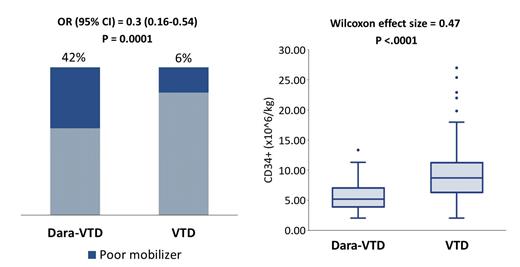Background
The pivotal clinical trial CASSIOPEIA established the quadruplet Daratumumab-Bortezomib-Thalidomide-Dexamethasone (Dara-VTD) as superior with regards to the standard Bortezomib-Thalidomide-Dexamethasone (VTD) regimen as induction therapy in newly diagnosed transplant-eligible (NDTE) multiple myeloma (MM) patients. As a matter of facts, Dara-VTD is currently the approved induction scheme in NDTE MM patients in Italy. Previous reports showed that adding Daratumumab in induction therapy patients yielded to a higher number of poor mobilizers, with a lower median number of collected hematopoietic stem cells (HSC). However, these reports included different types of induction therapies, merging patients on and off clinical trials, and real-life data focusing exclusively on Dara-VTD is lacking. We report our experience on the impact of Dara-VTD on HSC mobilization and collection, with a retrospective comparison with a cohort of patients treated with VTD and we also provided data concerning post-transplant engraftment and infectious complications.
Methods
From January 2022 to June 2023, 109 NDTE MM patients from 5 Haematology Institutions received Dara-VTD treatment induction according to the approved doses and schedule. The control group consisted of 116 age-matched patients treated with VTD in the years 2015-2016. Mobilizing therapy consisted of cyclophosphamide 1-3 gr/sqm followed by granulocyte colony-stimulating factor (G-CSF) 10 mcg/kg starting the 5th day thereafter, with HSC harvest planned on the 11th day. Patients received only G-CSF 10 mcg/kg if they were older than 70 years or had renal impairment (i.e., eGFR < 50 ml/min). Poor mobilizer was defined as having less than 20 CD34+/µL in peripheral blood on the 11th day after cyclophosphamide and G-CSF or on the 4th day of G-CSF alone administration. In that case, plerixafor was added at the standard dose of 0.24 mg/kg.
Results
In the Dara-VTD group, 96/109 patients received cyclophosphamide and G-CSF; among them, 3 patients had failed a previous G-CSF mobilizing therapy, even with the addition of plerixafor. Thirteen patients received G-CSF only. In the VTD group, all patients had received cyclophosphamide and G-CSF. Pre-harvest median number of CD34+/mL in the Dara-VTD group was 26 (range 0.8-279) vs 76 (range 20-294) in the VTD group and the incidence of poor mobilizing patients was 41.7% vs 5.9%, respectively (OR 0.3, 95% CI 0.16-0.54, P < 0.0001). Baseline disease characteristic did not have an impact on poor mobilizing events. On the contrary, patients who developed hematologic toxicity during induction turned out to be poor mobilizers (OR 3.5, 95% IC 1.36-9.59, p= 0.011). Plerixafor was used in 54/109 patients in the Dara-VTD group and in 16/116 patients of the VTD group. Two patients failed HSC mobilization both with G-CSF and cyclophosphamide and G-CSF. All patients that received G-CSF only resulted in poor mobilizers and required plerixafor before HSC harvest; therefore, cyclophosphamide showed to be superior with regards to G-CSF as mobilizing therapy (p= 0.011). The median number of collected HSC was significantly lower in the Dara-VTD group vs VTD group: 5.17 x 10^6/Kg (IQR 3.9-5.47) vs 8.7 x 10^6/kg (IQR 6.35-11.15), respectively (p < 0.0001). 33% of patients in Dara-VTD group collected at least 6 x 10^6 CD34+/Kg). Median time to neutrophils and platelets engraftment were different between the two groups (13 and 11 days, respectively, P < 0.0001), but we did not observe any difference in terms of infection incidence. Notably, post-transplant infections incidence in Dara-VTD group was 43%. Although the second transplant was planned for 36 patients treated with Dara-VTD, it was performed in 10 patients only, mainly because of insufficient HSC harvest.
Conclusions
Our experience with Dara-VTD confirms an increased number of poor mobilizers, a higher need for the use of plerixafor and a lower number of collected HSC. We observed a slightly lower engraftment in Dara-VTD group, probably because of a lower number of infused HSC. The lower number of collected HSC hampers the possibility of a double transplant.
Disclosures
Galli:Takeda: Honoraria; Sanofi: Honoraria; Menarini: Honoraria; Janssen: Honoraria; GSK: Honoraria; BMS: Honoraria; Amgen: Honoraria. Paris:Celgene: Honoraria; GSK: Honoraria; Takeda: Honoraria; Janssen-Cilag: Honoraria; Bristol Myers Squibb: Honoraria; Amgen: Honoraria. Mangiacavalli:Bristol Myers Squibb: Honoraria, Membership on an entity's Board of Directors or advisory committees; Sanofi: Honoraria, Membership on an entity's Board of Directors or advisory committees; Amgen: Honoraria; GlaxoSmithKline: Honoraria; Takeda: Honoraria, Membership on an entity's Board of Directors or advisory committees; Janssen: Honoraria, Membership on an entity's Board of Directors or advisory committees. Rambaldi:Astellas: Honoraria; Celgene-BMS: Honoraria; Janssen: Honoraria; Roche: Honoraria; Incyte: Honoraria; Novartis: Honoraria; Kite-Gilead: Honoraria; Jazz: Honoraria; Abbvie: Honoraria; Pfizer: Honoraria; Amgen: Honoraria; Omeros: Honoraria.


